Phylogeography and counter-intuitive inferences in island biogeography: evidence from morphometric markers in the mobile butterfly Maniola jurtina (Linnaeus) (Lepidoptera, Nymphalidae)
Abstract
Distribution of mobile organisms on near-continent islands is mainly shaped by factors operating over ecological rather geological time. However, the phylogeography of single species has the potential to expose historical factors at work. In the present study, West Mediterranean populations of the butterfly Maniola jurtina are studied using geometric morphometrics. The distribution of the two well established lineages (Maniola jurtina jurtina in the Atlanto–Mediterranean area and Maniola jurtina janira in the Central–Eastern-Mediterranean area) on 12 islands and the adjoining continents are compared. The south-western lineage unexpectedly occurs on islands close to shores occupied by the eastern lineage. We have modelled the distribution of the lineages using three different hypotheses: (1) a contemporary isolation model, which predicts lineage occupancy of islands is linked to relative distances from neighbouring continental areas; (2) a refugial hypothesis, which predicts one lineage to be the ancestral one for the whole region studied, and then successively replaced over part of it; (3) a changing geography hypothesis, which predicts the two lineages to have evolved in their currently occupied areas, continuously sourcing islands subsequent to the Würm maximum glaciation. Of the three models, the refugial hypothesis is most highly correlated with the observed pattern, suggesting that Mediterranean islands may function as refugia during cold periods, much as the three mainland peninsulas of Iberia, Italy and Greece are known to have done. Thereafter, hybridization on the nearest and smallest islands has occurred, with the entire process supporting the notion of the joint influence of factors in ecological and geological time. © 2009 The Linnean Society of London, Biological Journal of the Linnean Society, 2009, 98, 677–692.
INTRODUCTION
Studies of island biogeography often disclose a mix of contemporary and historical influences (paleogeography); separating these influences and determining their relative contribution is one of the main challenges of biogeography. A common finding is that contemporary geography is often found to dominate the outcome, particularly for mobile organisms such as butterflies (Dennis & Shreeve, 1996; Dennis et al., 2000a, 2008; Hausdorf & Hennig, 2005; Dapporto & Cini, 2007; Dapporto, Wolf & Strumia, 2007; Dapporto & Dennis, 2008; Fattorini, 2009). There are several possible reasons for this finding. First, data for modern geography (i.e. island configuration, size and isolation) are more accessible than for past geography; historical processes are inevitably more difficult to study. Second, the current shape of the coastline, although constantly changing, may well have been influencing island biogeography in much the same way for an undisclosed period of time; current geography may not simply measure events of a narrow time slice, especially when data for islands have accumulated over a period of time and when accurate information is lacking on island species' turnover. Third, historical processes influencing any fauna may be overwhelmed by contemporary ones or concealed in spatial patterns that mimic contemporary ones. There is a danger of assuming that ubiquitous species are mobile and served by nearest mainland sources. Finally, island studies have often focused on bulk comparisons (i.e. species richness, species diversity) rather than on individual species' incidences. In studies of richness and diversity, the most common species, typically the most dynamic species, are shown to have close links with sources, but rare species, typically less mobile endemics, may lack them and, in doing so, are bereft of past spatial signals (Dapporto & Dennis, 2008; Fattorini, 2009). A high incidence of mobile species may obscure historical factors associated with more limited sets of less mobile species, leading to an overestimation of the relative importance of contemporary factors (Dapporto & Cini, 2007; Fattorini, 2009).
A closer inspection of individual species' ecology in relation to source taxa and populations often exposes latent historical signals in island populations (Dapporto & Dennis, 2009). This is the case even in relatively recently colonized regions (e.g. British islands; Dennis & Shreeve, 1997). As such, the degree to which geological history influences distribution patterns is expected to vary in closely-related sets of organisms, as is more obviously the case for higher taxa (i.e. birds, large mammals, arthropods); closely-related species are not biologically or ecologically identical and thus should be affected differently by barriers and resource distributions. Clear palaeo-historical signals have been identified for island populations of mobile organisms, such as butterflies on larger Mediterranean islands (Dennis et al., 2000a; Dapporto & Dennis, 2008, 2009). Furthermore, there is no reason why historical and contemporary influences may not affect any one species differently in distinct parts of the same region, if only because the distribution of islands to potential sources generates different opportunities for that species, moderated by the species' ecology and biology. Butterflies differ in wing span, wing loading, larval host plant number, and distribution as well as in many other ways shown to be closely related to their geographical ranges and island occupancy (Quinn et al., 1997; Hill, Thomas & Lewis, 1999; Dennis et al., 2000b, 2004; Cowley et al., 2001a, b) However, it is no simple matter to disclose influences of geological history. Island endemic taxa, which are obvious historical material, do not necessarily make for good markers in island studies. Even in situations where sibling taxa do exist on nearby continents, current source distributions for them are unlikely to reflect past ones and thus historical pathways prove difficult or impossible to reconstruct. The difficulty is always a matter of not knowing what is missing, which taxa have become extinct, and, in the case of a fossil record, missing strata or strata vacant of fossil material pose serious deficiencies. The likelihood is that many historical signals are being missed in island biogeography studies simply because of the lack of suitable data. Phylogenetic markers can, nevertheless, be invaluable for disclosing historical events. This is most evident for immobile animals (e.g. freshwater fish: Tsigenopoulos et al., 2003; mammals: van der Made, Morales & Montoya, 2006). However, genetic markers have undoubted potential for revealing historical influences in mobile organisms with widespread distributions, namely in species that, to all extents and purposes, appear to have island distributions accordant with the contemporary geography (Hewitt, 2001; Schmitt, 2007).
Contemporary island geography conveys a number of intuitive expectations for colonization and extinction events (MacArthur & Wilson, 1967; Lomolino, 1986, 2000; Whittaker, 1998). Among these, colonization is most likely generated from nearby, larger sources than distant, smaller ones, and turnover (repeated extinction and colonization) is expected to be higher on smaller islands than larger ones. Accordingly, colonists on small islands should be more recent than those on equally isolated larger islands. Additionally, large and isolated islands may function as refugia for ancestral populations from invasion of new taxa spreading over the neighbouring mainland (Masini et al., 2008). Without regular and detailed auditing of species on islands or without convenient genetic markers, it would not be possible to assess whether these expectations are met in practice. In the present study, we investigate the phylogeography of the butterfly Maniola jurtina (Linnaeus) in the West Mediterranean. This butterfly is widely distributed throughout the West Palaearctic (Schmitt, Röber & Seitz, 2005). It is a mobile butterfly known to cross sea barriers and to engage in occasional mass movements (Dennis & Shreeve, 1996). Its overall distribution on West Mediterranean islands suggests that it is accounted for by contemporary geography rather than geological history (Dapporto & Dennis, 2009). Yet, at what is regarded as being at infraspecific level, this species has two major genetic lineages in Europe that meet in a hybrid zone through France and the West Mediterranean islands (Thomson, 1987; Schmitt et al., 2005). The existence of these lineages in M. jurtina provides a valuable opportunity to test a number of predictions:
- 1
If contemporary geography has determined the distribution of the two lineages on islands, populations on islands should have phylogenetic markers typical of those of their nearest potential sources.
- 2
If larger and more isolated islands have greater population inertia compared to smaller and less isolated islands, this should be reflected by the occurrence of paleo-distribution signals on them.
- 3
If, sensuSchmitt et al. (2005), the two lineages separated in western and eastern Mediterranean refugia during the last maximum glaciation, it is expected that West Mediterranean islands will have been colonized from neighbouring areas during the deglaciation process when islands were larger and less isolated. Successively, populations on islands would have ‘evolved’ by hybridization as a result of colonization from neighbouring continents, with colonization decreasing as the islands contracted in area and became more isolated.
MATERIAL AND METHODS
Model species and markers
The meadow brown butterfly M. jurtina (Linnaeus, 1758) forms conspicuous populations throughout much of the Mediterranean basin occupying continental southern Europe and North Africa, including most of the small and large Mediterranean islands and the Atlantic Canary Islands. For this reason, it has been used as a model species in several studies on phylogeography and speciation (Schmitt et al., 2005; Grill, Gkiokia & Alvarez, 2006; Grill et al., 2007), on adaptive variation, and on dispersal and habitat choice in natural and agricultural environments (Ford, 1964; Brakefield, 1982; Thomson, 1987; Conradt et al., 2000; Schmitt et al., 2005; Aviron, Kindlmann & Burel, 2007; Ouin, Martin & Burel, 2008). The two major genetic lineages in Europe are thought to have diverged during late Pleistocene (last stadial, 40 000 years BP): an Atlantic–Mediterranean lineage (Maniola jurtina jurtina) and a Central–Eastern-Mediterranean one (Maniola jurtina janira) (Schmitt et al., 2005; Schmitt, 2007). The variation in allozymes correlates closely with that of variation in male genital morphology and some wing attributes in the two lineages (Thomson, 1987; Schmitt et al., 2005). Despite the decisive importance of genetic data in phylogeography (Schmitt, 2007; Avise, 2009), mitochondrial DNA is maternally transmitted, and using it does not facilitate discrimination of hybrids, nor evaluation of male dispersion. On the other hand, application of nuclear loci in diploid organisms is complicated by difficulties in isolating haplotypes and by the phenomenon of intragenic recombination (Avise, 2009). However, genital morphology, unlike wing attributes, retains reliable genetic information in Satyrinae (Cesaroni et al., 1994), particularly in M. jurtina (Thomson, 1987; Schmitt et al., 2005), thus providing suitable markers for phylogeography. It was the analysis of male genitalia in this species that revealed the presence of a hybrid zone between the two lineages, extending from the Western Mediterranean Alps to the Benelux region (Thomson, 1987; Schmitt et al., 2005).
Study sample and genitalia preparation
A total of 264 males was examined belonging to the continental west Mediterranean area (Tunisia, N = 15; Morocco, N = 6; Spain, N = 15; France, N = 11; Northern Italy, N = 22; Southern Italy, N = 13), from nine offshore islands (Corsica, N = 23; Sardinia, N = 16; Sicily, N = 18; Elba, N = 21; Pianosa, N = 16; Giglio, N = 9; Mallorca, N = 15; Menorca, N = 11; Tenerife, N = 11), and from three fossil islands now attached to the Italian mainland (Argentario, N = 12; Uccellina, N = 16; Piombino, N = 14) (Fig. 1A; detailed specimen information is given in the Supporting information, Table S1). Geographical data for the islands are recorded in Table 1. Genitalia were dissected using standard procedures (Dapporto, 2008). Abdomens were boiled in 10% caustic potash. Genitalia were cleaned and the left valva and the aedeagus removed. The tegumen and right valva were mounted on euparal between microscope slides and cover slips. Genitalia were photographed using a Nikon coolpix 4500 camera mounted on a binocular microscope.
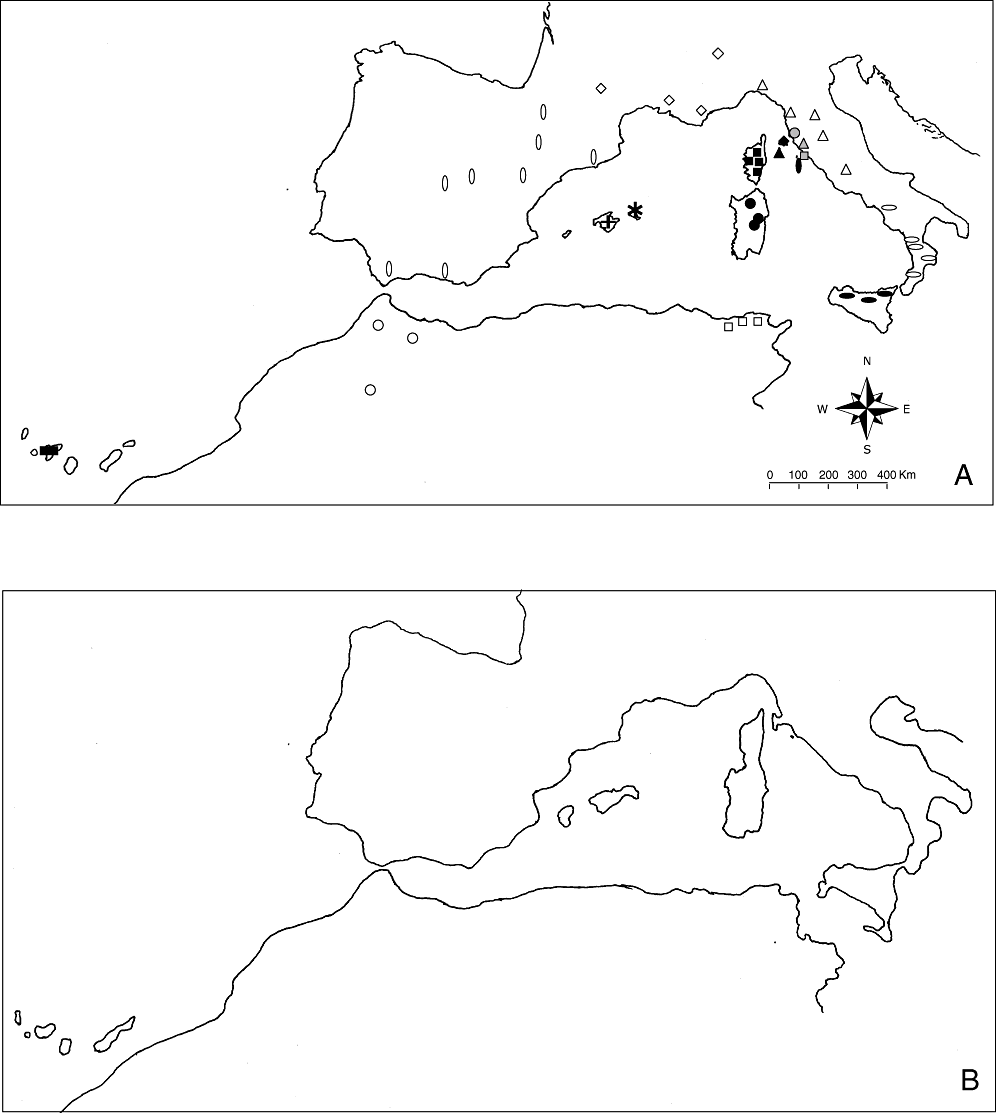
Map of the present-day dry land (A) and the extent of Würm land masses (areas delimited by the present 100-m bathymetric contour) (B). Symbols indicate collection localities in 18 different areas. Identification of the symbols is provided in the key in Fig. 3.
| Island | dNAR (km) | dSR (km) | dFR (km) | dIR (km) | dNAP (km) | dSP (km) | dFP (km) | dIP (km) | A R (km2) | A P (km2) | P R (km) | P P (km) |
|---|---|---|---|---|---|---|---|---|---|---|---|---|
| Corse | 445 | 440 | 165 | 80 | 150 | 410 | 160 | 30 | 8 681 | 11 400 | 850 | 1100 |
| Sardinia | 180 | 425 | 275 | 190 | 150 | 400 | 275 | 140 | 24 000 | 32 000 | 1263 | 1650 |
| Elba | 600 | 560 | 265 | 10 | 534 | 520 | 210 | 0 | 225 | 1 250 | 113 | 140 |
| Pianosa | 580 | 545 | 270 | 50 | 534 | 520 | 210 | 0 | 10 | 450 | 21 | 115 |
| Giglio | 556 | 615 | 310 | 15 | 520 | 600 | 310 | 7 | 24 | 42 | 24 | 42 |
| Sicily | 150 | 900 | 750 | 3 | 35 | 830 | 745 | 0 | 25 710 | 37 500 | 1328 | 2100 |
| Argentario | 570 | 640 | 330 | 0 | 545 | 610 | 320 | 0 | 70 | 80 | 48 | 54 |
| Piombino | 600 | 620 | 255 | 0 | 590 | 570 | 240 | 0 | 18 | 68 | 23 | 63 |
| Uccellina | 595 | 625 | 320 | 0 | 560 | 610 | 310 | 0 | 25 | 70 | 25 | 58 |
| Menorca | 312 | 190 | 350 | 605 | 225 | 100 | 235 | 540 | 690 | 1 700 | 188 | 210 |
| Mallorca | 265 | 160 | 280 | 680 | 225 | 100 | 235 | 540 | 3 640 | 7 500 | 478 | 950 |
| Tenerife | 290 | 1250 | 2150 | 2900 | 270 | 1240 | 2145 | 2850 | 2 034 | 2 060 | 260 | 263 |
Geometric morphometrics and statistical analysis
A combination of landmarks and sliding semi-landmarks was applied as in geometric morphometrics (Bookstein, 1997). This method permits quantitative explorations and comparisons of shape. The thin-plate spline software series (TPS) was used for these analyses (Rohlf, 2006a, b, 2007). The lateral sections of the tegument, of the brachia and of the valva were examined separately (Fig. 2). Three points on the outline of tegument and brachia and four on the valva that could be precisely identified were considered as landmarks (type II and type III landmarks; Bookstein, 1997), whereas the other points (sliding semi-landmarks) were allowed to slide along the outline trajectory to reduce uninformative variation (Bookstein, 1997) (Fig. 2). Digital data for landmarks on genital photographs were carried out using TPSDIG, version 2.10 (Rohlf, 2006a) and the definition of sliders using TPSUTIL, version 1.38 (Rohlf, 2006b).
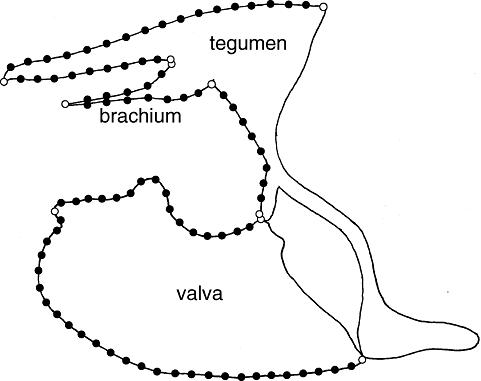
Schematic representation of fixed landmarks (open circles) and sliding semi-landmarks (black circles) considered in geometrical morphometric analyses.
Generalized procrustes analysis (GPA) was applied to the landmark data to remove nonshape variation in location, scale, and orientation, and to superimpose the objects in a common coordinate system (Bookstein, 1997). Using the shape residuals from GPA, we calculated the partial warps; these are sets of variables containing shape information. Applying principal components analyses (PCA) to partial warps, we obtained relative warps (RWs) that can be used as variables in discriminant analysis. Moreover, RWs can be visualized by thin-plate spline deformation grids, which permits a visual comparison of shape differences. GPA, partial warp and RW calculations and thin-plate spline visualization were carried out using TPSRELW, version 1.45 (Rohlf, 2007). The RW scores were analysed by discriminant analysis on the 18 groups of specimens from continental areas, islands, and fossil islands. Wilks' lambda and the percentage of correct assignments were used to evaluate the significance and validity of each discriminant function. Because the number of RWs is often numerous, we only included RWs explaining more than 1% in the discriminant analysis. To visualize the similarity pattern revealed by discriminant analysis, an average linkage cluster analysis (unweighted pair group method with arithmetic mean) that minimizes the distortion of the original data matrix was performed (Rohlf, 1970). The Euclidean distances matrix was calculated for the 18 areas using the mean scores from specimens in the discriminant functions having significant Wilks' lambdas.
Finally, the geographic position of islands and fossil islands was predicted from genital morphology of the analysed M. jurtina. A forward stepwise general linear model (F to enter and F to remove = 1.00) was applied; the latitude and longitude of the sites for continental specimens acted as dependent variables and the RW scores as independent variables. The latitude and longitude of each specimen from islands and fossil islands were subsequently predicted from the model derived from continental specimens. To verify which areas showed a significant ‘displacement’, a Wilcoxon sign test was carried out between the observed and predicted latitude and longitude for specimens of each island and fossil island.
Geographic measures
Island areas have been taken from different official sources. According to several studies (Dapporto & Cini, 2007; Fattorini, 2009; M. J. Tooley, pers. comm.) Pleistocene coastal geography has been inferred from the 100-m isobath (Fig. 1B). Isolation from the four mainland areas have been extracted from a 1 : 1 000 000 Atlas (Istituto Geografico de Agostini). In the same way, we measured minimal distances between island and continental 100-m isobaths. Recent and Pleistocene island perimeters and Pleistocene island areas were measured by ImageJ (http://rsbweb.nih.gov/ij/) using profiles of recent and 100-m isobaths from 1 : 2 250 000 maps.
Hypotheses
Three hypotheses were tested in relation to the present and past geography of the West Mediterranean:
Recent isolation hypothesis
A first expectation is based on the idea that the two M. jurtina lineages evolved on the mainland, and occupied islands through continuous immigration. This hypothesis assumes that colonization is inversely related to distance(s) from sources. Potential sources are regarded as the nearest continental shore. According to Thomson (1987) and Schmitt et al. (2005), four main continental sources exist with populations having western (Spain, North Africa), eastern (Italy) or hybrid (France) male genitalia morphs. Genitalia morphs can be identified from discriminant functions separating western from eastern continental areas. Centroid values for functions in discriminant analysis describe the mean genitalia shape for each source and island. The expected shape for each island can be considered as the average shape of colonists from continental sources weighted for their colonization potential (isolation):
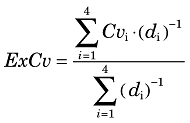 (1)
(1)where ExCv is the expected centroid values for a given island, Cv is the observed centroid values of the ith sources and di is the minimal distance between an island and the ith source. Finally, we computed two different ExCv based on quadratic and nonquadratic functions of isolation.
Refugial hypothesis
The second expectation is based on the potential function of islands as refugia for ancestral populations. This expectation relates to the probability of turnover. Turnover is predicted to be higher for less isolated and smaller islands. Owing to their smaller populations, smaller islands are expected to have much greater turnover than larger islands; thus, their populations are expected to be most closely related to their nearest geographical sources. For example, immigration from the Italian mainland to a small island such as Giglio should be relatively high and any small ancestral population should be readily replaced by hybridization after colonization. On the other hand, ancestral populations on the largest islands such as Sicily, Sardinia, and Corsica, are expected to persist for thousands of years. The similarity of populations on islands to those at sources should rank inversely with island size (potential population persistence), whereas the probability of immigration from the mainland will correlate directly with an island's perimeter and inversely with its distance from each source.
This approach assumes that ancestral populations occur on islands prior to M. jurtina lineages occupying mainland shores. The status of island populations directly depends on island area. As such, the centroid value (for genital shape) of ancestral populations is weighted by island area:
 (2)
(2)where Apop is the weighted population shape, A is island area, and Cv the ancestral shape inhabiting the island. The prediction model assumes that the ancestral population over the whole continental studied area was the western one. This is suggested by the unexpected presence of the western lineage in several Italian islands and by the recent findings of Weingartner, Wahlberg & Nylin (2006), who revealed that the North African population of the Satyrinae butterfly Pararge aegeria (Linnaeus) represents the ancestral lineage for all European species and forms of Pararge. Thus, the centroid value of Cv of the African source is assumed to be the ancestral form (CvA). We hypothesize that the eastern lineage successively invaded Italy, hybridized with the western lineage and dispersed to islands. Initially, some propagules may successfully migrate to and colonize islands generating hybrid populations having intermediate shapes between the island ancestral one and that at the source:
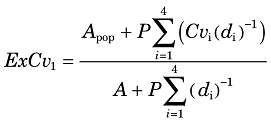 (3)
(3)Where ExCv1 is the expected shape at step one, P island perimeter, Cvi is the centroid values for the ith source, di is the minimal distance between the island and the ith source. To identify a predicted evolution of shape in the islands and fossil islands studied, an iterative model was applied in which ExCv1 was treated as the ancestral shape with introgression established in successive steps for ExCv2, thus simulating ongoing colonization and hybridization. The procedure was iterated with 200 steps in Microsoft EXCEL:
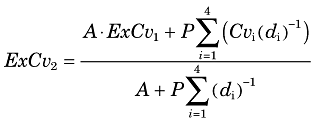 (4)
(4)Changing geography hypothesis
A third hypothesis is that the two lineages evolved in their currently occupied mainland areas during the last glacial stage maximum (Schmitt et al., 2005), when the lowering of the sea level facilitated colonization of islands from sources. Subsequently, immigrants have continuously invaded the islands during a changing environment (reduction of island perimeter and island area, increased distance to mainland). To test this hypothesis, we used eqn. 1 to predict the population shapes on de novo colonized islands but using Würm maximam geographic values:
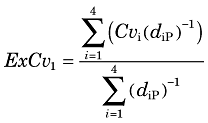 (5)
(5)Where diP is island isolation from the ith source during the Würm glacial stage. Then, we divided the variance between Würm glacial stage and recent values for island perimeter, area, and isolation from each source into 200 equal parts (an arbitrary value facilitating fine increments of change) and we defined ε as 1/200. The model used for the second hypothesis (eqn. 3) was then iterated to predict the ‘evolution’ of island populations' genitalia shapes in a continuously changing geography. At each of the 200 steps, 1/200 = ε of its variance was added to perimeter, area and isolation:
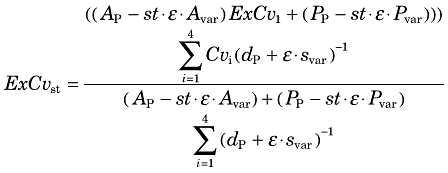 (6)
(6)Where Ap is Pleistocene area, st is the number of the step (from 1–200), Pp is Pleistocene perimeter, dp is Pleistocene isolation and Avar, Pvar, and Svar are variances between Pleistocene and recent values of island area, perimeter, and isolation, respectively.
The match between observed and predicted centroid values for each iteration was tested using Pearson correlations. The power of the function in predicting the lineage present on each island was based on the percentage of individuals that are correctly assigned to their lineage. Statistical analyses were performed using Statistica 7 (Statsoft).
RESULTS
We obtained 26, 28, and 88 RWs from analyses of the tegument, brachia, and valva, respectively. More than 1% of variance was explained for ten tegumen RWs, eight brachia RWs, and 11 valva RWs (a cumulative variance of 97.7%, 96.9%, and 94.5%). Discriminant analysis identified four significant functions (function 1, explaining 72.1% of variance, Wilks' lambda = 0.003, P < 0.001; function 2, explaining 5.8% of variance, Wilks' lambda = 0.038, P < 0.001; function 3, explaining 4.8% of variance Wilks' lambda = 0.69, P < 0.001; function 4, explaining 4.3% of variance Wilks' lambda = 0.117, P = 0.001). RWs belonging to valva and brachia (valva RW1 and brachia RW1) are included in the first function. Function 2 is represented by tegumen and brachia relative warps (tegumen RW3, tegument RW9, brachia RW6), function 3 by valva RW4 and function 4 by valva relative warps RW2 and RW3. On the basis of such functions, single populations cannot be completely identified and only 69.3% of cases have been correctly assigned. However, there is a clear distinction between the two continental groups among which no specimens have been misclassified (Fig. 3). The first group contains specimens from North Africa (Tunisia and Morocco) and Spain; the second contains specimens from Northern and Southern Italy. Specimens from France occupied an intermediate position but with a greater similarity to those from Italy. All specimens from Tenerife, Mallorca, Menorca, Sardinia, and Sicily have been classified into the first group. Specimens from Corsica and Pianosa have been mostly classified together with the first group with some exceptions. Specimens from Elba and Giglio occupy an intermediate position between the two groups. All specimens from Italian fossil islands have been grouped together with Italian specimens (Fig. 3). Accordingly, cluster analysis revealed three main clusters, with the first one grouping together southern and northern Italian specimens with those belonging to fossil islands, the second one grouping together the possible intermediate (hybrid) areas (France, Corsica, Pianosa, Elba, Giglio), and the third grouping together North Africa and Spain with the remaining islands (Sardinia, Sicily, Tenerife, Mallorca, and Menorca) (Fig. 4).
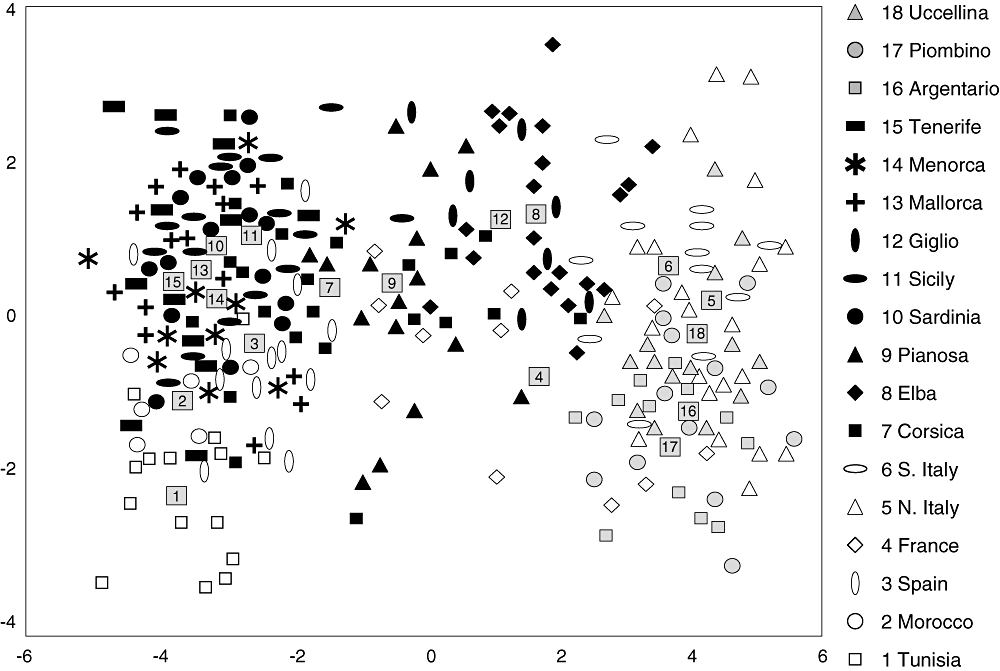
Discriminant analyses displaying relative positions of specimens belonging to the 18 different areas. Numbered squares represent centroids; discriminant function 1 and function 2 are represented on the x- and y-axis, respectively.
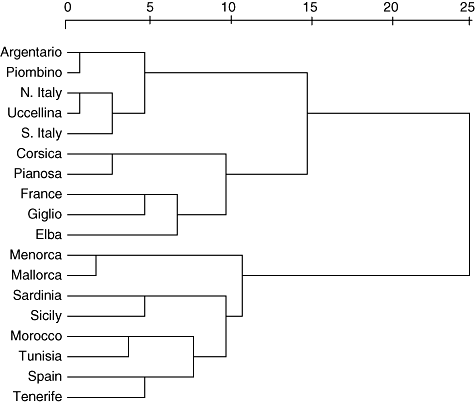
Dendrogram obtained by unweighted pair group method with arithmetic mean clustering of areas according to their Euclidean distance matrix from significant discriminant analysis functions.
A stepwise general linear model revealed that the valva RW1 (t = −3.59, P < 0.001), RW2 (t = 2.78, P = 0.007) and RW6 (t = 2.34, P < 0.022), and tegumen RW3 (t = 2.91, P = 0.004) and RW4 (t = 2.77, P = 0.007) are significantly correlated with latitude, and valva RW1 (t = −3.56, P < 0.001), RW2 (t = 2.29, P < 0.025), RW6 (t = 2.23, P < 0.029) and RW8 (t = 3.16, P = 0.002) are significantly correlated with longitude. Relative warps RW1 and RW2 of valvae comprising the highest explained variance in geometric morphometrics and the highest significance in discriminant analysis and general regressions, are shown in Figure 5. The differences in shape highlighted by geometric morphometrics largely reflect descriptions of the two main populations inhabiting Europe, the western population (M. j. jurtina showing a larger distal portion of the valva and a narrower dorsal process) and the eastern one (M. j. janira showing a narrower distal part of the valva and a larger dorsal process); the brachia of M. j. jurtina have larger distal parts compared to those in M. j. janira.
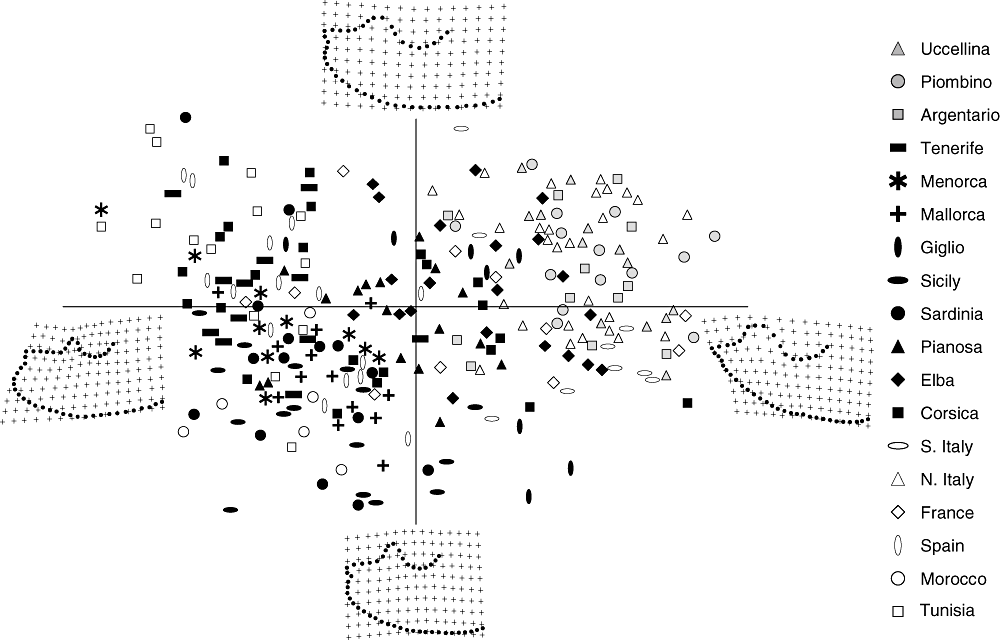
Graphical representation of the first (x-axis) and of the second (y-axis) relative warps of the valva analysis. Variations in shape along both axes are shown in thin-plate spline deformation grids.
The predicted positions of islands differ. Figure 6 shows the predicted longitude and latitude (±SE) of each island and fossil islands. It is clear that Elba and Giglio are only slightly displaced towards the south-west, whereas all the other islands are grouped in the proximity of the Balearic archipelago substantially displaced from their actual locations. Fossil islands are predicted to be located close to their actual positions. Predicted values of both latitude and longitude are significantly higher than observed ones for Tenerife (Wilcoxon test: latitude, Z = −2.936, P = 0.003; longitude, Z = −2.936, P = 0.003). Conversely, they are significantly lower from observed ones for Sardinia (Wilcoxon test: latitude, Z = −3.413, P = 0.001; longitude, Z = −3.516, P < 0.001), Corsica (Wilcoxon test: latitude, Z = −3.954, P < 0.001; longitude, Z = −3.954, P < 0.001) and Pianosa (Wilcoxon test: latitude, Z = −3.516, P < 0.001; longitude, Z = −3.516, P < 0.001) (Fig. 6). Mallorca has a lower predicted latitude and a higher predicted longitude than observed (Wilcoxon test: latitude Z = −2.897, P = 0.004; longitude Z = −2.613, P = 0.009) whereas the predicted longitude of Sicily is significantly lower than that observed (Wilcoxon test: Z = −3.621, P < 0.001) while the predicted latitude does not differ from that observed (Wilcoxon test: Z = −1.681, P = 0.093). Elba, Giglio and Menorca specimens generated latitudes lower than predicted (Elba, Wilcoxon test: Z = −3.007, P = 0.003; Giglio, Wilcoxon test: latitude, Z = −2.380, P = 0.017; Menorca, Wilcoxon test: Z = −2.191, P = 0.028), whereas there is no difference between predicted and observed values for longitudes (Elba, Wilcoxon test:, Z = −0.852, P = 0.394; Giglio, Wilcoxon test: Z = −0.840, P = 0.401; Menorca, Wilcoxon test: Z = −0.459, P = 0.646). Finally, the three Italian fossil islands are predicted to be located in close proximity to their observed locations (Fig. 6) and the only significant difference to emerge is of a higher than predicted longitude for Piombino (Uccellina, Wilcoxon test: latitude, Z = −0.227, P = 0.820; longitude, Z = −0.852, P = 0.394; Argentario, Wilcoxon test: latitude, Z = −0.784, P = 0.433; longitude, Z = −0.549, P = 0.583; Piombino, Wilcoxon test: latitude, Z = −0.345, P = 0.730; longitude, Z = −2.291, P = 0.022).
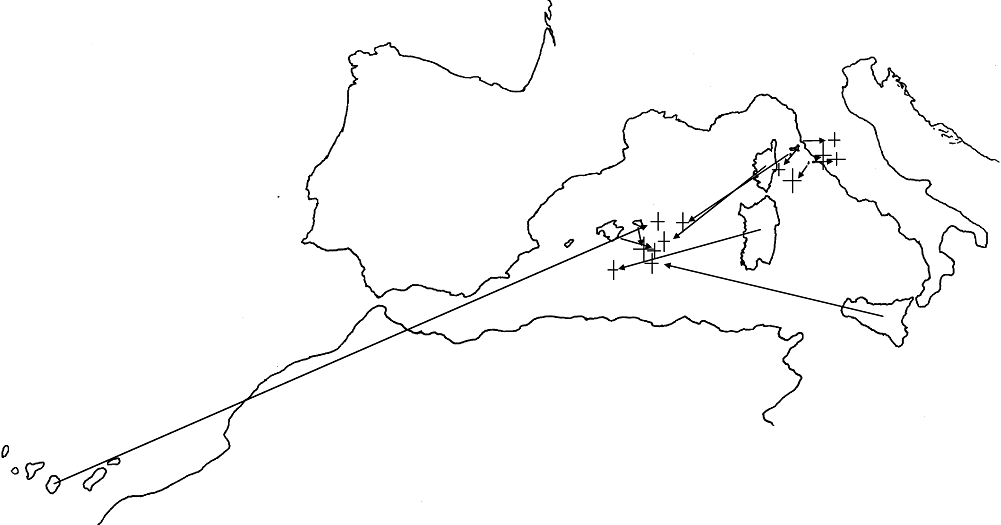
Representation of the morphological displacements of each islands. Centres (crosses) represent the mean ± SE predicted values of latitude and longitude and whiskers.
Prediction of genitalia shape based on contemporary influences (eqn. 1) revealed that Sicily, Sardinia, Pianosa, and Corsica unexpectedly have a negative (western) genitalia shape (Fig. 7A). The Pearson correlation between observed and predicted values of discriminant analysis function 1 scores is uniformly 0.79 (Fig. 7D) and the percentage of correctly assigned cases is 66.7%. A similar result was obtained from the changing geography model (eqn. 6) with a maximum Pearson correlation value of 0.81 and a maximum percentage of 66.7% for populations correctly assigned to their lineages (Fig. 7C, D). Conversely, the refugial hypothesis model (eqn. 3) generated a predicted temporal trend characterized by an instantaneous change from the western to the eastern lineage for the fossil islands and a rapid transformation of the three small islands close to the Italian Peninsula (Elba, Pianosa, and Giglio). Sicily also changed rapidly but to a degree retarded by its large area (Fig. 7B). Yet more isolated Sardinia and Corsica are predicted to retain their ancestral populations for some time despite their greater proximity to the eastern lineage. Tenerife, Mallorca, and Menorca are invariably predicted to be occupied by the western lineage. The Pearson correlation and percentages of cases correctly assigned are clearly higher in the refugial hypothesis compared to the other two hypotheses. In particular, the Pearson correlation has a peak value of 0.94 and, in some steps, 100% of cases are correctly assigned to their group.
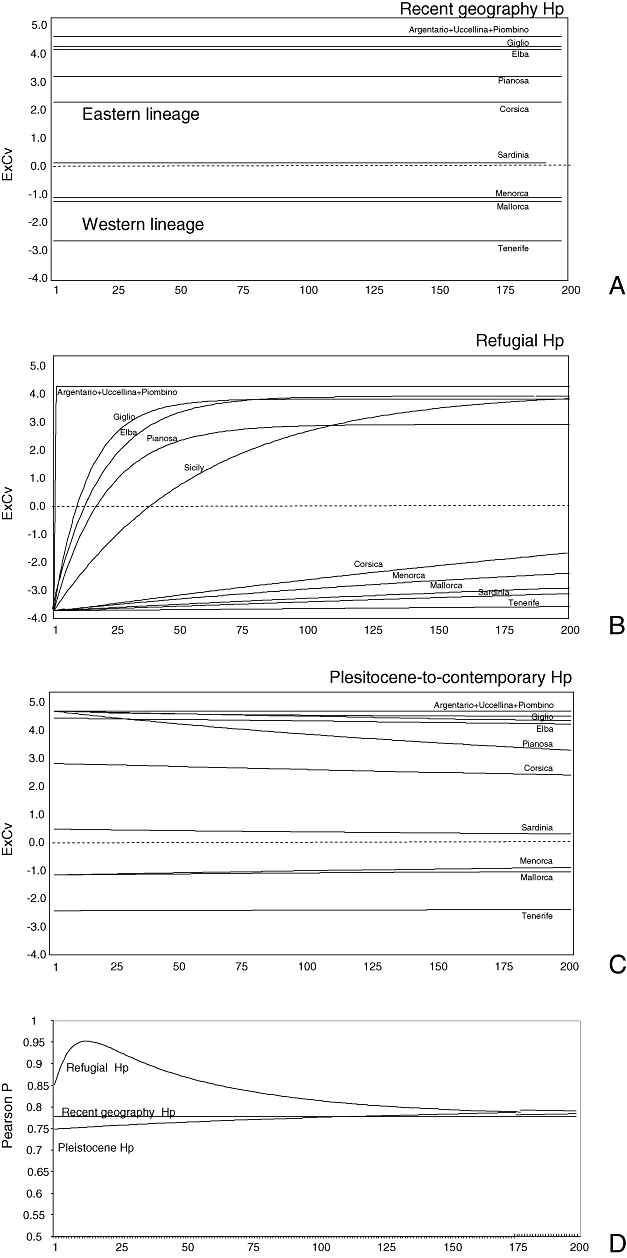
Expected shape (ExCv) for island populations in the three different hypotheses: recent isolation (A), refugial (B), and changing geography (C). Graphs show the evolution of the predicted shape over 200 iterations. D, trend in Pearson correlations for each of the three hypotheses in the 200 iterations.
DISCUSSION
An outstanding issue in island biogeography is the extent to which latent historical influences underlie the island geography of mobile organisms (Hausdorf & Hennig, 2005; Fattorini, 2009). Examination of this issue has required a model organism whose distribution is characterized by distinctive phylogenetic markers. The regional differences in M. jurtina genital morphology have enabled a direct comparison of affiliations to be made between island and mainland source populations bearing on some basic island biogeography notions. The study has focused on three in particular: (1) that distribution of the two lineages in Southern Europe probably changed after their evolution during the last stadial maximum ice advance (in particular, the comparison of insular and mainland populations suggests that the Eastern lineage replaced the Western one in Italy); (2) that colonists are most likely to have arrived from the nearest mainland sources and thus the make-up of island populations will reflect isolation from neighbouring sources; and (3) that greater inertia (persistence) is associated with larger populations on larger islands than on smaller ones and thus populations on larger islands should comprise more ancestral traits. The expected outcome of an island biogeographic analysis depends much on the combination of island size and isolation; the combination of island size and isolation is largely responsible for driving island biogeography dynamics (colonization, hybridization, extinction) from the geological past to the immediate present. For example, ancestral populations on islands are less likely to be overwhelmed by colonists from distinct source populations when isolated rather than when close to those sources. However, the persistence of ancestral populations will depend on the size of islands and, thus, the number of local population units (metapopulation structure; Hanski & Gilpin, 1997). Ancestral populations on large islands should persist longer than those on small islands. In the present study, the morphology of M. jurtina on islands has been directly modelled on these basic notions of island biogeography: for past to present coastline configuration. The results suggest an ongoing evolution of M. jurtina genital morphology for island populations.
Characterization of island source affiliations for M. jurtina
Initially, there is confirmation of the taxonomic division of Europe into two distinct groups of M. jurtina on genital shape (Thomson, 1987; Schmitt et al., 2005) as well as the hybrid zone in France. A traditional morphometrics approach for quantitatively assessing genital shape has established the validity of genitalia as a taxonomic marker for population affinity in this butterfly, as indeed in other species (Cesaroni et al., 1994). Individual butterflies are classified to the mainland source groups (jurtina in Spain and Africa versus janira in Italy) without overlap and island populations have distinctive frequency distributions in genital shapes. Subsequently, a regression technique has disclosed substantial and significant distortion in the configuration of West Mediterranean island geography based on male genital morphology. This demonstrates that although some islands occupy predicted positions in accord with contemporary geography, others are significantly displaced, a result that compels a view of past (geological) influences on source-island associations. Unexpectedly, a number of islands, instead of reflecting associations with their nearest mainland potential sources, usually the eastern form (janira), have their closest morphological links with the western form (jurtina). Not only are the relatively isolated large islands of Sardinia and Corsica morphologically displaced westwards, but so is the largest island Sicily abutting the Italian peninsula, as well as the smaller islands directly offshore of the Italian peninsula, Elba, Giglio and Pianosa. The only populations showing no influence of the western mainland sources are those on the fossil islands embedded in the Italian peninsula and juxtaposed to populations with eastern morphology. Tenerife is unusually drawn significantly eastwards if only because the continental source markers are all to the east of its Atlantic location. To put it simply, the map of West Mediterranean islands based on genital morphology is not the current map of the Mediterranean Basin.
Modelling affiliations between island and source populations
Match and mismatch between genital morphology of island populations and source populations has at least three distinct causes: the influence of past and present geography (migration from sources) and refugial capacity (inertia). Although it is likely that each factor has a part to play in island genital morphology, the models developed to test the influence of these potential factors purposely separate these influences. Thus, although there is a significant association between the observed and expected island morphology for each model, they differ in the amount of explained variation and the degree to which individuals can be correctly classified to islands. The models also cater for an unknown in the colonization–hybridization process (i.e. the extent to which colonization, and thus hybridization, by later incursions has progressed on each island). At the outset, this remains for at least two reasons. First, it is not known how compatible two introgressing taxa are likely to be, and therefore the degree to which hybridization can take place and has progressed. This can be described as the degree of inertia posed by potential refugial populations on islands. Second, it cannot be assumed that the distribution of the two taxa has been constant over geological or historical time. Current species' geographical range shifts over the past 15 years (Parmesan et al., 1999; Hill et al., 2002) demonstrates just how extensively an organism's geography can change over ecological time. However, two of the models (refugial, changing geography) have been allowed to ‘evolve’ in steps (recent geography is obviously a constant) and, although these steps are arbitrary, the associations (correlations) between observed and simulated morphology for island populations suggest how far the process of change may have progressed. Specifically, the maximum correlation between predicted and actual outcomes in the stepwise process describes a stage reached in population changes.
A comparison of models suggests that a number of factors influence the pattern of genital morphology. First, configuration of West Mediterranean island and source coastal geography is an important component in explaining island genital morphology; this supports the existence of an active system of island-source dynamics. Yet, it is interesting that the recent West Mediterranean shoreline configuration is as important as configurations at any time during the Late Glacial and Holocene, from the nadir of the maximum glacial advance (18 000 years BP). It would be surprising if shore to island isolation had not been an important contributor to island population status and island-neighbouring shore affiliations. The butterfly is known to be mobile (Dennis & Shreeve, 1996; Shreeve, Dennis & Williams,1995) and, even though long distance overseas migration (> 50 km) may be rare, diffusion from sources is likely to have been an ongoing process for millennia. As it is, there is a substantial and very similar correlation (r = 0.79 to 0.81) between observed and expected morphology patterns for islands based on island isolation, both past and present.
Second, there is a clear indication that many, especially large, islands contained refugial (ancestral) populations prior to subsequent immigration to islands during the Late Glacial and Holocene, with deglaciation. If the morphological pattern of refugial populations simply mirrored opportunities for colonization immediately on deglaciation (i.e. source population morphology at that stage), then the Late Glacial shoreline model would generate much the same agreement between observed and expected genital morphological profiles as the refugial model. Indeed, the refugial model produces by far the highest correlations (r = 0.94) and correct classifications of individuals on islands.
Third, the refugial model ultimately fails to sustain the initial very high correlations and individual correct classifications. This suggests that there would be steady ‘erosion’ of ancestral patterns by ongoing migration and colonization as each model tends towards the same equilibrium given by eqn. 1. However, it is evident that this state (i.e. equilibrium in line with current geography) has not yet been reached. This observation is confirmed not just by the staging (timing) of maximum correlations between observed and expected island morphologies to early steps in the refugial model, but also by the observation that current island-source associations cause extensive distortion of West Mediterranean geography based on genital shapes.
The inference of these findings is of an earlier colonization (and refuge) of western ‘jurtina’ in the whole continental area investigated in the present study (North Africa, Spain, France, and Italy) and a later migration and colonization of ‘janira’ in the Italian Peninsula and subsequently on neighbouring islands. It would be difficult to explain the pattern of genital morphology on Sicily and Sardinia by assuming a reversal of these influences, particularly because western forms of genitalia are absent from the Balkans and the Aegean islands (Thomson, 1987). This process does not appear to have been unique even for this taxon (Maniola). The presence of the endemic, Maniola nurag (Ghiliani), on Sardinia, suggests that this scenario, the shifting conjunction of sibling taxa, may well be replicated with glacial–interglacial cycles, and this species is perhaps the product of an earlier event (stadial) in the same glacial–interglacial (Grill et al., 2007). Dennis, Williams & Shreeve (1991) and Dennis, Shreeve & Williams (1995) argued for repeated contraction and refuge of widespread European butterfly species to the eastern and western Mediterranean, where the core populations persist and continue to diverge through the climatic cycles. The evidence for this scenario is contained in the numerous sibling butterfly taxa, contrasting in divergence in western and eastern Europe (Dennis, 1993; Dennis & Schmitt, 2009). Interestingly, the genital morphology of M. nurag is intermediate in shape between the two forms of M. jurtina (L. Dapporto, unpubl. data). However, the existence of M. nurag as a distinct taxon demonstrates that the large Mediterranean islands can form long-term refuges for butterfly species and other organisms during severe climatic cycles (Dapporto & Dennis, 2009). Sardinia has other good examples of endemic butterflies [e.g. Papilio hospiton (Gené), Polyommatus gennargenti (Leigheb); Marchi et al., 1996; Aubert et al., 1997]. Undoubtedly, it is notoriously difficult to data the origin of these sibling taxa. However, if Schmitt et al. (2005) are correct and the M. jurtina forms are relatively recent, originating during the last (Devensian) maximum glaciation, the western Mediterranean islands could well have been refuges for the western form during the Late Glacial climatic downturn (minor glacial readvance of the Upper Dryas, approximately 11 000–10 000 years BP) attaining the islands, initially as a result of fewer physical barriers and prevailing westerly winds (Pierini & Simioli, 1998), with the eastern form spreading more slowly, apprehended by the Apennine Chain, during the Holocene. In accordance with these observations, a recent study by Masini et al. (2008) demonstrated that large and small Pleistocene fossil mammals on Western Mediterranean islands did not all become extinct at the same moment in time on continents and islands. In particular, climatic changes largely affected continental and near-to-continent island faunas (e.g. Sicily). Conversely, on the highly isolated Sardinia, no apparent correlations occurred between climatic oscillations and faunal composition. Several species survived longer in Sardinia, thus emphasizing an important function of this island as a stable refugiumamid the plant and animal dynamics occurring over continental areas.
In Tenerife, M. jurtina inhabits a substantially lower latitude compared with the populations on the African mainland. This island is located 250 km off the African coast, and the nearest M. jurtina mainland population is found circa 1000 km away (Tarrier & Delacre, 2008). This distance is excessive for dispersal by this butterfly. It is possible that M. jurtina may have colonized Tenerife during some glacial maximum advance when climatic conditions were favourable to its life on the neighbouring Sahara coastline. Owing to a zone of higher precipitation on the north side of the island (Whittaker, 1998), Tenerife may represent a post-glacial temperate refugium for successive glaciations. An alternative view is that M. jurtina is a recent Holocene colonist linked to human occupation of the islands. This hypothesis is supported by the close similarity in wing phenotype and genital structure between Tenerife and North Africa populations (Owen & Smith, 1990) (Fig. 5). Because populations on several Mediterranean islands are morphologically distinct from those at their nearest sources, it is atypical that M. jurtina has not diverged in the novel environment of the Canary Islands. However, the possibility remains that Tenerife may represent a refugium for M. jurtina, and genetic analysis should be carried out in order to clarify this hypothesis.
The current findings for M. jurtina on West Mediterranean islands warn against assuming that species with broadcast island distributions are single genetic entities whose colonization history is founded on nearest mainland sources. The distribution of another satyrinae butterfly, Hipparchia aristaeus (Bonelli), occurring in North Africa, Sardinia, Corsica, Sicily, and on many Italian islets, but replaced by Hipparchia semele (Linnaeus) in continental Europe, largely reflects that of M. j. jurtina, (Cesaroni et al., 1994). The question arises: how many ubiquitous species whose genetic structure remains unknown have a colonization history similar to that for M. jurtina in the West Mediterranean. Even in thoroughly explored islands there are surprises; testament to this is the recent discovery that Leptidea reali (Reissinger), and not Leptidea sinapis (Linnaeus), is the main wood white species found in Ireland, whereas L. sinapis is restricted to an ecological island, the Burren limestone pavement (Nelson et al., 2001). As Ireland underwent glacial tabula rasa for current butterfly species (Dennis, 1993), the late Würm origins of these two species clearly relates to refugia at Mediterranean latitudes and the division of isolated genetic populations, much as for M. jurtina, during a glacial maximum advance. Butterfly species on Mediterranean islands may have persisted for orders of magnitude longer than those on the British islands (Dennis & Shreeve, 1997). Thus, further research on islands in the West Mediterranean will undoubtedly reveal further unexpected genetic distinctions and associations. These findings also expand our knowledge on European post glacial colonization history from Mediterranean refuges. To date, five of the potential combinations of colonization pathway, referred to as colonization paradigms (Hewitt, 1999, 2000; Schmitt, Gießl & Seitz, 2003; Schmitt, Röber & Seitz, 2005; Habel, Schmitt & Müller, 2005; Habel et al., 2008; Weingartner et al., 2006; Schmitt, 2007), have been described emanating from four mainland areas: Iberia, Italy, the Balkans, and North Africa. These pathways focus attention on movement north into Europe from the Mediterranean. None considers integration within the Mediterranean basin itself or the potential of the larger islands as refuges, sources and stepping stones for species during deglacial recolonization of Europe. The present study demonstrates a more complex state of affairs, with Sardinia, Sicily, and Corsica clearly functioning as refuges, and possibly also as sources, for the smaller Italian offshore islands.
ACKNOWLEDGEMENTS
Our grateful thanks are extended to Professor Michael J. Tooley for his advice on Pleistocene coastlines and to Roger Vila, Stefano Scalerico, Vlad Dinca, and Luca Bartolozzi for the loan of several specimens. This study was conducted in collaboration with the Tuscan archipelago National Park and partially funded by the ENEL and Legambiente project ‘Insieme per la Biodiversità: un santuario per le farfalle nel Parco Nazionale dell'Arcipelago Toscano’.




